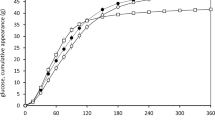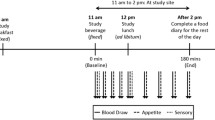Abstract
Purpose
Berries and mixed berry products exert acute effects on postprandial glycaemia and insulinemia, but very few berries have been studied, and primarily in normal weight subjects. Sea buckthorn and strawberry are compositionally widely different berries and may likely produce different responses. The effects of strawberry and sea buckthorn on postprandial glycaemia and insulinemia were examined in overweight or obese male subjects. Subjective appetite sensations and ad libitum intake were also examined.
Methods
The study was conducted as a randomised, controlled, single-blinded, three-way crossover study. Eighteen subjects were studied in three 2-h meal tests followed by a subsequent ad libitum meal. Test meals contained added sucrose and either sea buckthorn, strawberry or no berries with added fructose (control). Blood samples were collected at t = 0, 30, 45, 60, 90 and 120 min. Subjective appetite sensations were recorded at t = 0, 15, 30, 45, 60, 90, 120, and 140 min and subsequent ad libitum intake was recorded. Statistical differences in all continuous measures were evaluated based on the existence of a meal or a time–meal interaction by repeated measures linear model analyses or by differences in AUC by linear mixed models.
Results
None of the berries affected postprandial glucose. However, sea buckthorn improved glycaemic profile (44.7%, p < 0.01) compared to control. Sea buckthorn also resulted in a decrease in plasma insulin concentration at 30 min (39.6%, p < 0.01) and at 45 min (16.5%, p < 0.05) compared to control and the maximal increase in plasma insulin was lower following sea buckthorn compared with control (23.6%, p < 0.01). Strawberry did not affect postprandial insulin concentrations compared to control. No differences between control and each of the two berries were observed for any of the appetite parameters, except for desire for something sweet, which was increased following the sea buckthorn meal compared to control.
Conclusions
There was no effect on postprandial glucose response to a sugar challenge given together with purees of strawberry or sea buckthorn. Sea buckthorn decreased and delayed the insulin response and improved glycaemic profile compared with control. Strawberry had no such effects. No important differences were seen for the appetite measures. Sea buckthorn might be useful as a culinary tool for lowering meal insulin response.

Similar content being viewed by others
References
Ludwig DS (2002) The glycemic index: physiological mechanisms relating to obesity, diabetes, and cardiovascular disease. JAMA 287(18):2414–2423
Raben A (2002) Should obese patients be counselled to follow a low-glycaemic index diet? No Obes Rev 3(4):245–256
Blaak E, Antoine JM, Benton D et al (2012) Impact of postprandial glycaemia on health and prevention of disease. Obes Rev 13(10):923–984
Wolever TM (2006) The glycaemic index: a physiological classification of dietary carbohydrate. Cabi, Oxfordshire
Atkinson FS, Foster-Powell K, Brand-Miller JC (2008) International tables of glycemic index and glycemic load values: 2008. Diabetes Care 31(12):2281–2283
Szajdek A, Borowska EJ (2008) Bioactive compounds and health-promoting properties of berry fruits: a review. Plant Foods Hum Nutr 63(4):147–156
Hanhineva K, Törrönen R, Bondia-Pons I, Pekkinen J, Kolehmainen M, Mykkänen H, Poutanen K (2010) Impact of dietary polyphenols on carbohydrate metabolism. Int J Mol Sci 11(4):1365–1402
Mithril C, Dragsted LO, Meyer C, Blauert E, Holt MK, Astrup A (2012) Guidelines for the new nordic diet. Public Health Nutr 15(10):1941–1947
Poulsen SK, Due A, Jordy AB, Kiens B, Stark KD, Stender S, Holst C, Astrup A, Larsen TM (2014) Health effect of the new nordic diet in adults with increased waist circumference: a 6-mo randomized controlled trial. Am J Clin Nutr 99(1):35–45
Mithril C, Dragsted LO, Meyer C, Tetens I, Biltoft-Jensen A, Astrup A (2013) Dietary composition and nutrient content of the new nordic diet. Public Health Nutr 16(5):777–785
Fødevaredata (2017) DTU Fødevareinstituttet. http://frida.fooddata.dk/. Accessed 18 Mar 2017
Giampieri F, Tulipani S, Alvarez-Suarez JM, Quiles JL, Mezzetti B, Battino M (2012) The strawberry: composition, nutritional quality, and impact on human health. Nutrition 28(1):9–19
Suryakumar G, Gupta A (2011) Medicinal and therapeutic potential of sea buckthorn (Hippophae rhamnoides L.). J Ethnopharmacol 138(2):268–278
Törrönen R, Sarkkinen E, Tapola N, Hautaniemi E, Kilpi K, Niskanen L (2010) Berries modify the postprandial plasma glucose response to sucrose in healthy subjects. Br J Nutr 103(8):1094–1097
Törrönen R, Sarkkinen E, Niskanen T, Tapola N, Kilpi K, Niskanen L (2012) Postprandial glucose, insulin and glucagon-like peptide 1 responses to sucrose ingested with berries in healthy subjects. Br J Nutr 107(10):1445–1451
Edirisinghe I, Banaszewski K, Cappozzo J, Sandhya K, Ellis CL, Tadapaneni R, Kappagoda CT, Burton-Freeman BM (2011) Strawberry anthocyanin and its association with postprandial inflammation and insulin. Br J Nutr 106(6):913–922
Park E, Edirisinghe I, Wei H, Vijayakumar LP, Banaszewski K, Cappozzo JC, Burton-Freeman B (2016) A dose–response evaluation of freeze-dried strawberries independent of fiber content on metabolic indices in abdominally obese individuals with insulin resistance in a randomized, single-blinded, diet-controlled crossover trial. Mol Nutr Food Res 60(5):1099–1109
Lehtonen H, Järvinen R, Linderborg K, Viitanen M, Venojärvi M, Alanko H, Kallio H (2010) Postprandial hyperglycemia and insulin response are affected by sea buckthorn (Hippophaë rhamnoides ssp. turkestanica) berry and its ethanol-soluble metabolites. Eur J Clin Nutr 64(12):1465–1471
Yang B, Karlsson RM, Oksman PH, Kallio HP (2001) Phytosterols in sea buckthorn (Hippophae rhamnoides L.) berries: Identification and effects of different origins and harvesting times. J Agric Food Chem 49(11):5620–5629
Yang B, Kallio H (2002) Composition and physiological effects of sea buckthorn (Hippophaë) lipids. Trends Food Sci Technol 13:160–167
Bastard JP, Maachi M, Lagathu C, Kim MJ, Caron M, Vidal H, Capeau J, Feve B (2006) Recent advances in the relationship between obesity, inflammation, and insulin resistance. Eur Cytokine Netw 17(1):4–12
Cuparencu CS, Andersen MBS, Gürdeniz G, Schou SS, Mortensen MW, Raben A, Dragsted LO (2016) Identification of urinary biomarkers after consumption of sea buckthorn and strawberry, by untargeted LC–MS metabolomics: a meal study in adult men. Metabolomics 12:31
Livsmedeldatabasen (2015) Livsmedelverket. https://www.livsmedelsverket.se/livsmedel-och-innehall/naringsamne/livsmedelsdatabasen/. Accessed 18 Mar 2017
Flint A, Raben A, Blundell JE, Astrup A (2000) Reproducibility, power and validity of visual analogue scales in assessment of appetite sensations in single test meal studies. Int J Obes Relat Metab Disord 24(1):38–48
Gilbert JA, Gasteyger C, Raben A, Meier DH, Astrup A, Sjödin A (2012) The effect of tesofensine on appetite sensations. Obesity 20(3):553–561
Rosen L, Silva LO, Andersson UK, Holm C, Ostman EM, Björck IM (2009) Endosperm and whole grain rye breads are characterized by low post-prandial insulin response and a beneficial blood glucose profile. Nutr J 8:42
Törrönen R, Kolehmainen M, Sarkkinen E, Poutanen K, Mykkanen H, Niskanen L (2013) Berries reduce postprandial insulin responses to wheat and rye breads in healthy women. J Nutr 143(4):430–436
Huang Y, Park E, Edirisinghe I, Burton-Freeman BM (2016) Maximizing the health effects of strawberry anthocyanins: understanding the influence of the consumption timing variable. Food Funct 7(12):4745–4752 7(
Richter CK, Skulas-Ray AC, Gaugler TL, Lambert JD, Proctor DN, Kris-Etherton PM (2017) Incorporating freeze-dried strawberry powder into a high-fat meal does not alter postprandial vascular function or blood markers of cardiovascular disease risk: a randomized controlled trial. Am J Clin Nutr 105(2):313–322
Clegg ME, Pratt M, Meade CM, Henry CJ (2011) The addition of raspberries and blueberries to a starch-based food does not alter the glycaemic response. Br J Nutr 106(3):335–338
Granfeldt YE, Björck IM (2011) A bilberry drink with fermented oatmeal decreases postprandial insulin demand in young healthy adults. Nutr J 10:57
Linderborg KM, Jarvinen R, Lehtonen HM, Viitanen M, Kallio HP (2012) The fiber and/or polyphenols present in lingonberries null the glycemic effect of the sugars present in the berries when consumed together with added glucose in healthy human volunteers. Nutr Res 32(7):471–478
Törrönen R, Kolehmainen M, Sarkkinen E, Mykkänen H, Niskanen L (2012) Postprandial glucose, insulin, and free fatty acid responses to sucrose consumed with blackcurrants and lingonberries in healthy women. Am J Clin Nutr 96(3):527–533
Matthews D, Hosker J, Rudenski A, Naylor B, Treacher D, Turner R (1985) Homeostasis model assessment: insulin resistance and β-cell function from fasting plasma glucose and insulin concentrations in man. Diabetologia 28(7):412–419
Linderborg KM, Lehtonen HM, Jarvinen R, Viitanen M, Kallio H (2012) The fibres and polyphenols in sea buckthorn (Hippophae rhamnoides) extraction residues delay postprandial lipemia. Int J Food Sci Nutr 63(4):483–490
Granfeldt Y, Wu X, Björck I (2006) Determination of glycaemic index; some methodological aspects related to the analysis of carbohydrate load and characteristics of the previous evening meal. Eur J Clin Nutr 60(1):104–112
Zeb A, Mehmood S (2004) Carotenoids contents from various sources and their potential health applications. Pak J Nutr 3(3):199–204
Häkkinen SH, Kärenlampi SO, Heinonen IM, Mykkänen HM, Törrönen AR (1999) Content of the flavonols quercetin, myricetin, and kaempferol in 25 edible berries. J Agric Food Chem 47(6):2274–2279
Tadera K, Minami Y, Takamatsu K, Matsuoka T (2006) Inhibition of ALPHA-glucosidase and ALPHA-amylase by flavonoids. J Nutr Sci Vitaminol 52(2):149–153
Fang XK, Gao J, Zhu DN (2008) Kaempferol and quercetin isolated from Euonymus alatus improve glucose uptake of 3T3-L1 cells without adipogenesis activity. Life Sci 82(11):615–622
Voutilainen S, Nurmi T, Mursu J, Rissanen TH (2006) Carotenoids and cardiovascular health. Am J Clin Nutr 83(6):1265–1271
Cooper DA (2004) Carotenoids in health and disease: recent scientific evaluations, research recommendations and the consumer. J Nutr 134(1):221S-4S
Ulmius M, Johansson A, Önning G (2009) The influence of dietary fibre source and gender on the postprandial glucose and lipid response in healthy subjects. Eur J Nutr 48(7):395–402
Farajian P, Katsagani M, Zampelas A (2010) Short-term effects of a snack including dried prunes on energy intake and satiety in normal-weight individuals. Eat Behav 11(3):201–203
Flood-Obbagy JE, Rolls BJ (2009) The effect of fruit in different forms on energy intake and satiety at a meal. Appetite 52(2):416–422
Gregersen NT, Flint A, Bitz C, Blundell JE, Raben A, Astrup A (2008) Reproducibility and power of ad libitum energy intake assessed by repeated single meals. Am J Clin Nutr 87(5):1277–1281
Gregersen NT, Møller BK, Raben A, Kristensen ST, Holm L, Flint A, Astrup A (2011) Determinants of appetite ratings: the role of age, gender, BMI, physical activity, smoking habits, and diet/weight concern. Food Nutr Res 55
Acknowledgements
We thank the study group including kitchen staff (Karina Graff Rossen in particular), laboratory technicians (especially Pia Lisbeth Madsen) and all our participants for their participation in the study. The study was part of the OPUS project “Optimal well-being, development and health for Danish children through a healthy New Nordic Diet”. The OPUS Centre was supported by a grant from the Nordea Foundation, Denmark, and is independent of all commercial interests.
Author information
Authors and Affiliations
Corresponding author
Ethics declarations
Conflict of interest
The corresponding author, Lars Ove Dragsted states that there is no conflict of interest for all participating authors.
Electronic supplementary material
Below is the link to the electronic supplementary material.
Rights and permissions
About this article
Cite this article
Mortensen, M.W., Spagner, C., Cuparencu, C. et al. Sea buckthorn decreases and delays insulin response and improves glycaemic profile following a sucrose-containing berry meal: a randomised, controlled, crossover study of Danish sea buckthorn and strawberries in overweight and obese male subjects. Eur J Nutr 57, 2827–2837 (2018). https://doi.org/10.1007/s00394-017-1550-8
Received:
Accepted:
Published:
Issue Date:
DOI: https://doi.org/10.1007/s00394-017-1550-8




